As preparations for major tournaments go, Canada’s women’s football team’s has been far from ideal, with disputes between the players and the governing body, Canada Soccer, over equal pay and funding cuts leading to the former refusing to take part in training or matches (although they later backtracked on this after being threatened with legal action), before then seeing the news filter through that influential winger Janine Beckie was to miss the World Cup with an ACL injury.
With Beckie being so important to Canada’s tactics, this was always going to be a major blow for them as they built up towards the trip down under this summer, and there will now be questions surrounding how Bev Priestman looks to replace her presence and quality in order to not jeopardise her side’s chances of going deep into the tournament.
With that in mind, this tactical analysis will take a look at what Priestman’s options now are, with a specific look at whether a change of shape is needed or whether they can simply find a player with a similar profile to the former Manchester City Women player and make a like-for-like replacement.
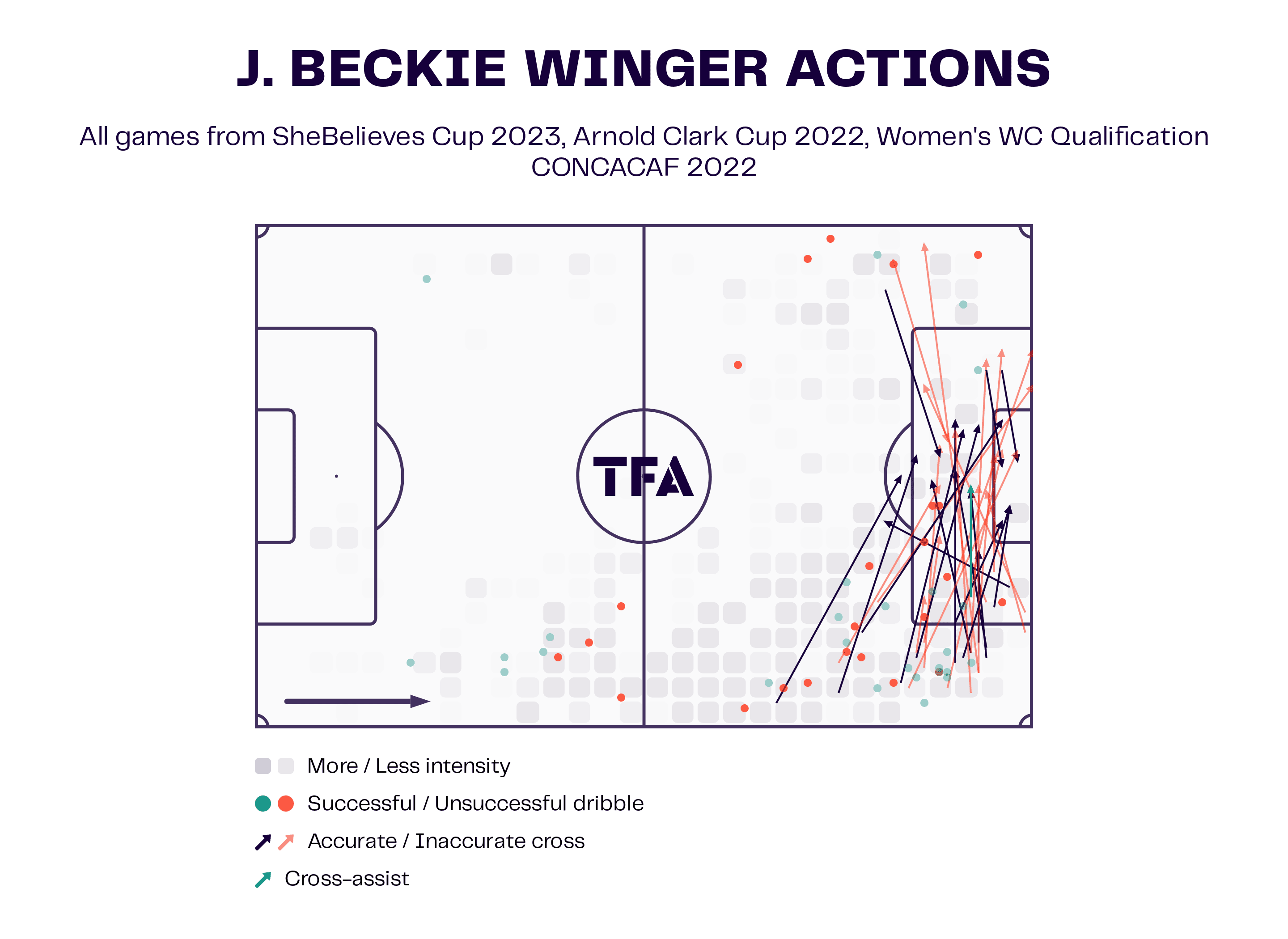
To get a better idea of what that profile is though, this analysis will first look at exactly what Beckie brings to Canada’s attacking play.
From the graphic, what is immediately clear is that her main role, and the thing that she is best at, is sending the ball into the middle from wide areas, with the number of attempted crosses indicating how it is clearly the first thing on her mind whenever she receives the ball.
However, it is also important to look at the areas that her crosses originate from, because there are a number of those that found their target that come from deeper areas, rather than all being sent in from near the goal line. Therefore, again, this indicates that it is often her first thought when she gets the ball and she rarely hesitates or second-guesses herself, and that clarity is another reason that she has been so important to her national side over the last few years.
The fact that she opts not to dribble with the ball often is indicated by the number of unsuccessful dribbles that she made, with each orange dot illustrating a move that didn’t come off. Therefore, even though there are a sizeable number of successful dribbles, it is not something that she is consistently good at, and that is important to mention because it means that any replacement for her also doesn’t need to have that quality in their skill set.
Playing previously without Beckie
This has now set out a clear profile of what type of player is needed to replace Beckie, but before going into how Canada could go about finding someone to fit those specifications, it is first important to mention that this is not the first time that Priestman has had to find a way of playing without the Portland Thorns forward, with her previously being unavailable for their double header with Brazil at the end of last year.

As a result, fans got a first look at what Canada might do to try and fill the gap that she left open, and, in the first of those games, Priestman opted to start Manchester United Women’s Adriana Leon and Benfica Feminino’s Cloé Lacasse in the wide roles, trying to use their pace and ability to beat opponents to create advanced targets and to stretch the team vertically.
There were a lot of positives to take from that combination of players, but there was also one glaring negative, which came in the shape of Lacasse cutting inside the field on plenty of occasions and trying to get a shot away at goal herself. It was only natural that she did this, with her being a striker by trade, and someone that Benfica rely on time and time again for goals, but it meant that Brazil found it very easy to defend against Canada once they have got back to set up their defensive line, with them able to stay narrow and not need to worry about moving out towards the wings.
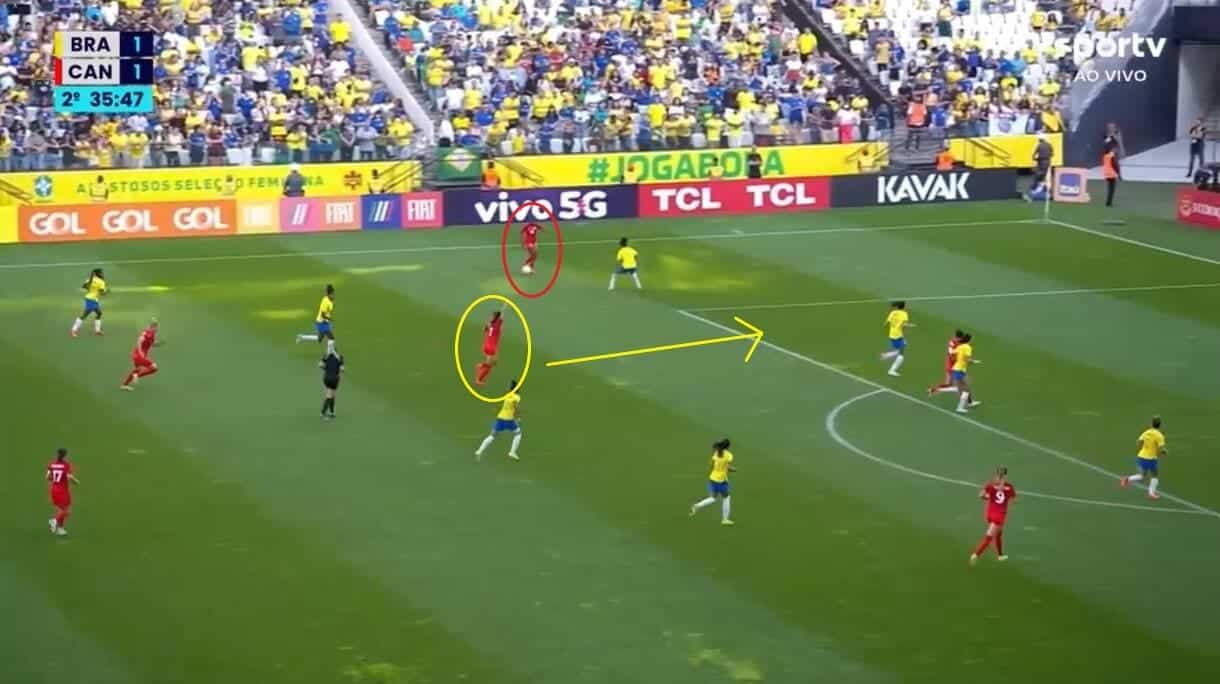
This was something that Priestman evidently realised as the game went on because she introduced Nichelle Prince in the second half of that game and then started the Houston Dash player in the second match ahead of Lacasse, with Leon keeping her place in both games, and the difference between the two was that Prince, being a wide forward and not a striker, tended to stay in the wide channels for longer periods of the game.
With her on the field and staying further out, Brazil now had to alter their own tactics, and it is clear to see how they have both gone out to meet the ball and simultaneously maintained their compact shape in the middle. This has now created a gap in the line that wasn’t there before, and that is what Priestman wanted to see, with that now allowing Juventus Femminile star Julie Grosso to make a run into the space and get into areas where she has shown throughout her short career that she can have an effect on the field.
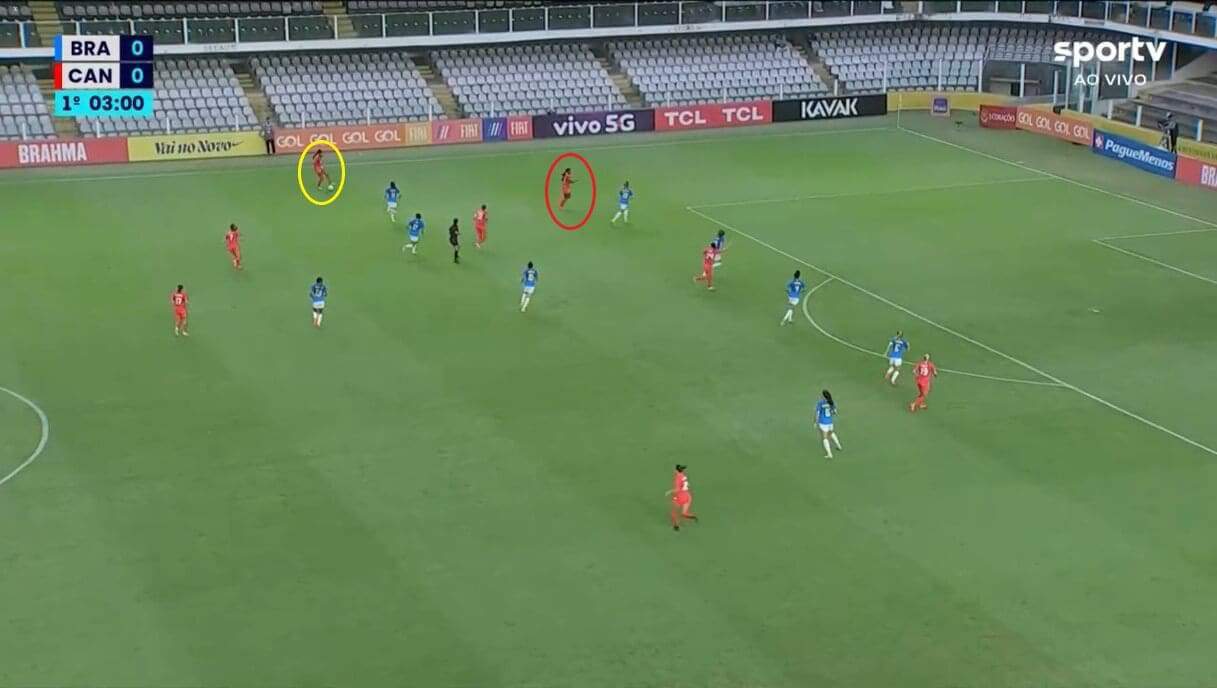
However, the fact still remained that Prince, like Lacasse, has a natural instinct to move inside the pitch and try to get shots away at goal, and there were times that she did that in both games against Brazil.
Therefore, Priestman knew that she needed to find a way of allowing that to happen whilst also ensuring that the width didn’t disappear, and her solution was to push the two full-backs higher up the field and get them to play outside Prince and Leon, giving them the licence to play more narrowly and link up with those in the middle, and it can be seen here how PSG Féminine’s Ashley Lawrence, who played at left-back in this game, is doing just that here.
It helps that Lawrence is an attack-minded full-back anyway, so this was not something that she was unfamiliar with. However, the overall progress in Canada’s performances during those two games was clear, with them starting out by trying something and then tweaking it during the international break, and the fact that they seemed to have a way of playing without Beckie at the end of it that didn’t prohibit individual players from playing to their strengths demonstrated that it can be done.
Change of shape
However, playing with advanced full-backs in that manner is incredibly risky, because it does leave the defensive line exposed and the team open to counterattacks. Therefore, whilst it can be relied upon to support attacks, it is not a sustainable system for a team to play in if they are susceptible to direct attacks from opponents.
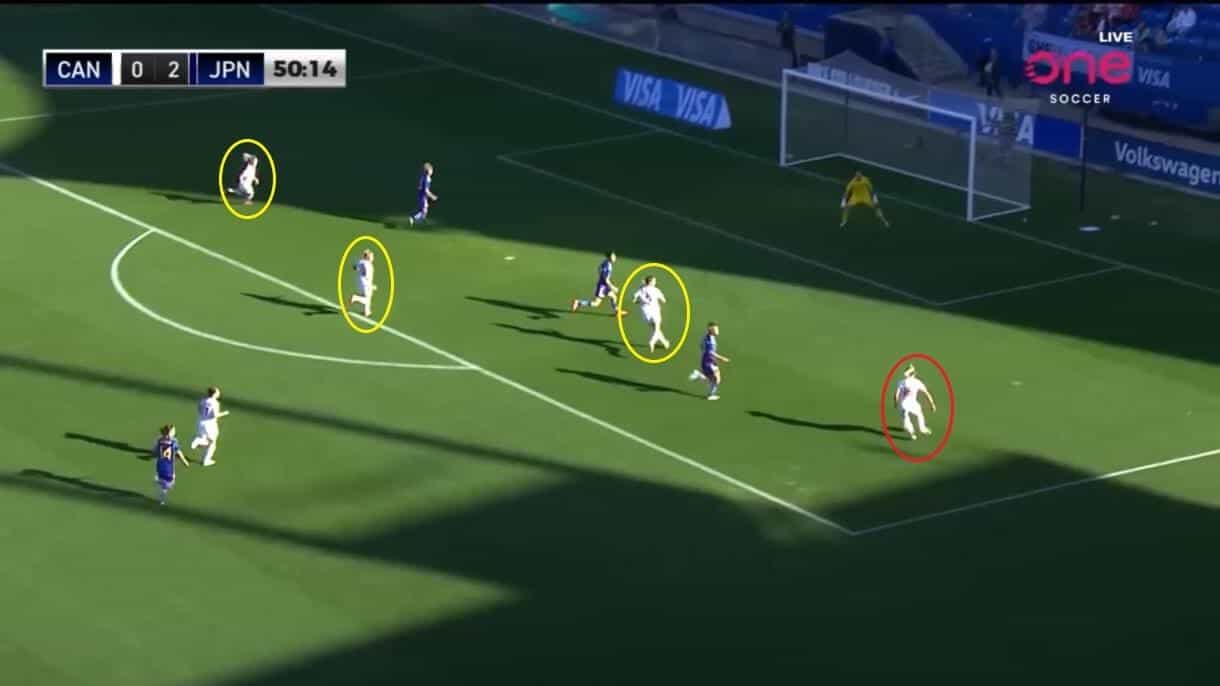
With that in mind, Canada need to find a way of maintaining the width using their wingers and to limit their tendencies to move inside the field, and one way to go about this might be to change the attacking shape of the team and introduce either a 4-4-1-1 or a 4-4-2 starting formation. In their most recent game, a 3-0 loss to Japan, they did set the team up in the former, and the advantages of it when it comes to the final third are clear to see, with two players now in the middle, one winger making an inverted run to offer a deeper passing option and the other winger (in this case Beckie) holding her position and looking for a player to pass to.
However, when looking at the overall picture, the question that needs to be asked is whether, if there was one player here, the two wingers would have been more tempted to both run inside the field and the answer, depending on who was playing, is most likely yes. Therefore, tweaking the shape and forcing those in the wide roles to stay outside the central third might be one way to solve that problem.
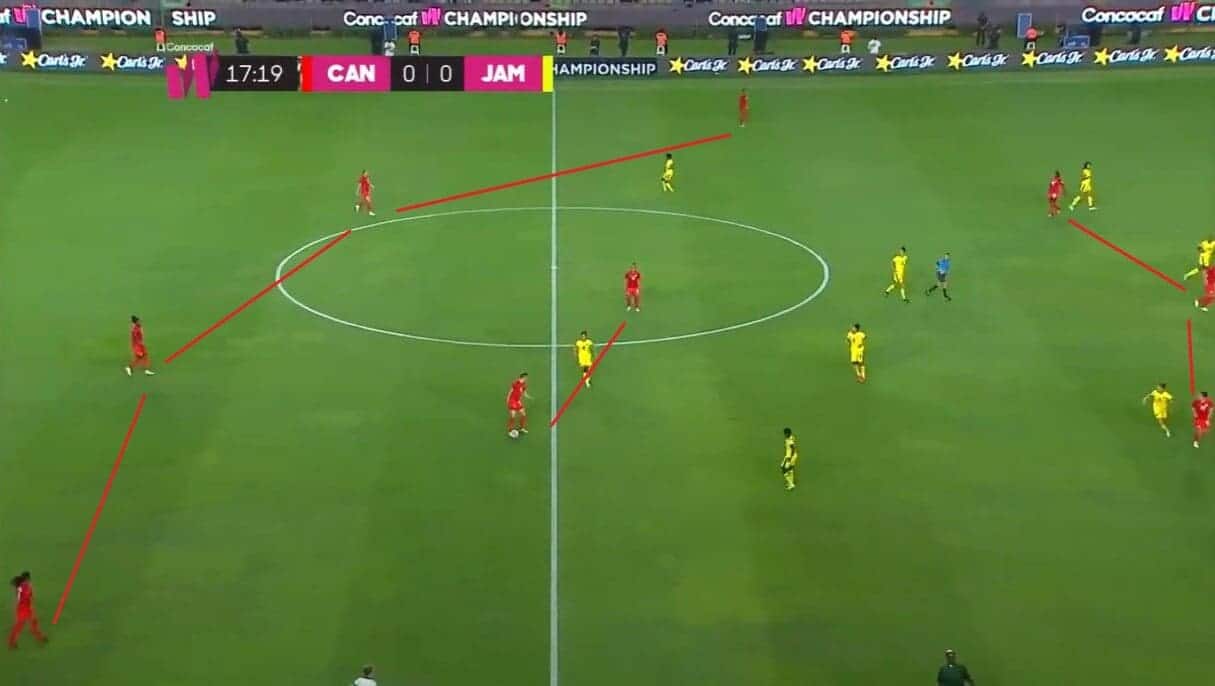
Another might be to abandon that way of thinking and instead deploy a 4-3-3, as they did against Jamaica in last year’s Concacaf W Championship. By playing with that formation, Canada effectively took the shackles off of their two wide forwards and gave them the freedom to stay further infield and play in closer proximity to the central striker.
The advantage of this system is that it allows a team to create numerical overloads in the middle of the field, and, against Jamaica, who set up with a back five, this proved to be particularly useful. Therefore, if Canada are unable to find a player who is capable of staying out on the wing and delivering balls into the middle, then this could be something worth exploring as an alternative system.
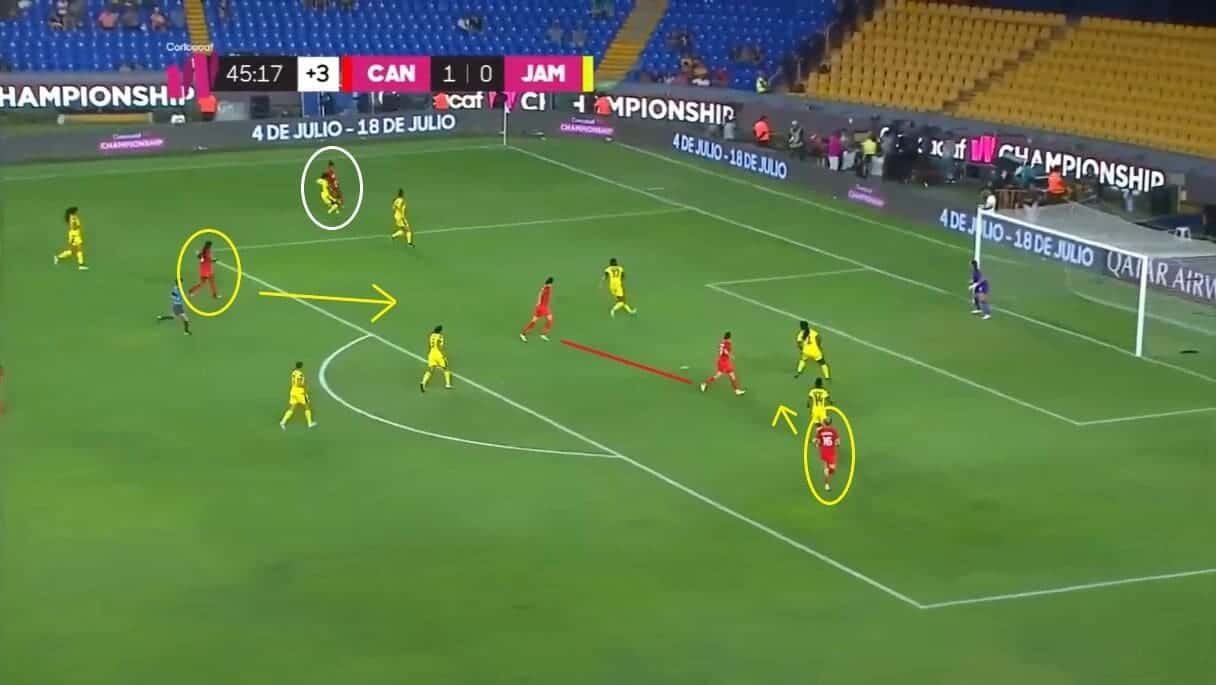
The only problem is that it would still rely on the full-backs getting forward to control the wide channels, and that might lead to discussions about wing-backs being introduced in order to allow them to stay further forward and not need to focus so much on tracking back once possession has been lost. It is not something that Priestman has seemingly considered before, but, if she did take the plunge and decide to make that structural alteration, then she might be more comfortable playing with a narrow front three, and it might lead to more productivity which could be important against teams with more robust defensive shapes.
Different players
If Priestman decides that the best course of action at the World Cup is to stay true to what she has already implemented during her time with the team, which would mean sticking with the 4-2-3-1 formation that they have used so often under her, then the thinking immediately turns towards finding a player who would stay in the wide areas, and that might be an opportunity for some of those currently on the fringes to come into the side and stake a claim to be part of the starting 11.
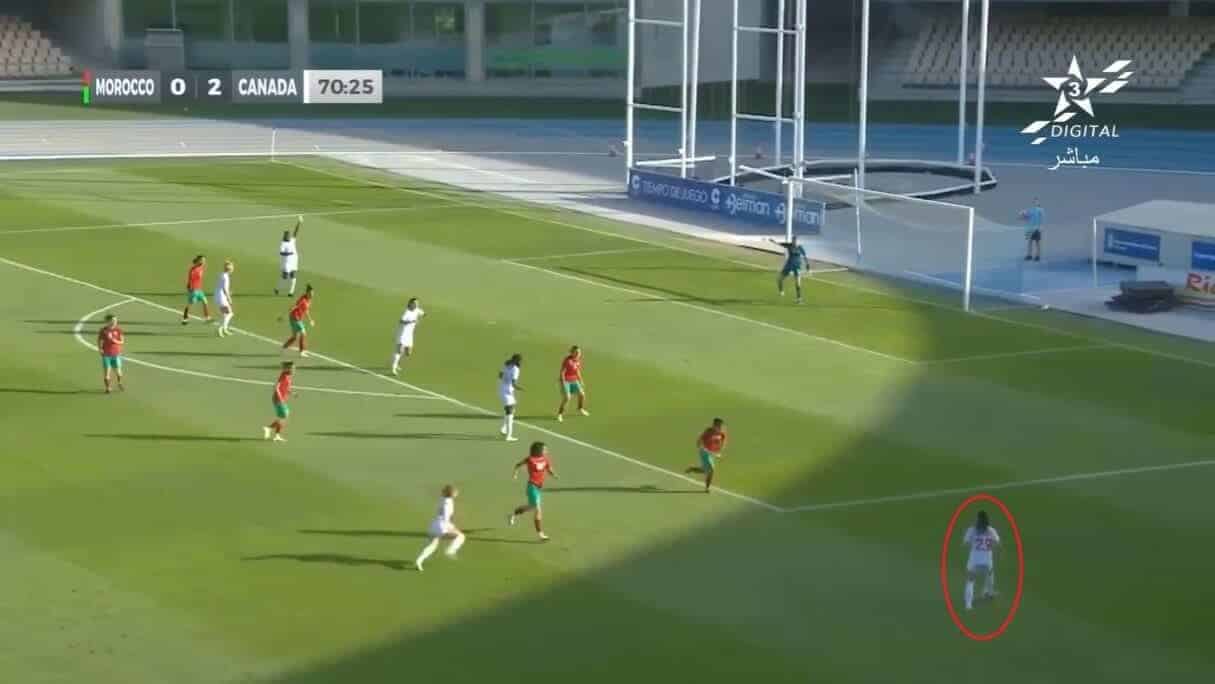
One player who might be considered is Clarissa Larisey, who left Celtic Women in January to join Swedish side BK Häcken after impressing for the Scottish side during the first half of the campaign.
At the age of 23, the Ottawa-born forward has so far been awarded just five caps for her country, but it is clear that she has a future with the side and can provide them with quality if she is given chances to shine. Where she might come in handy now is that she can stay in the wide channels and draw defenders out of position, with Morocco being tempted to close the ball down here and leaving Canada with one less player to worry about once the cross is delivered into the middle.
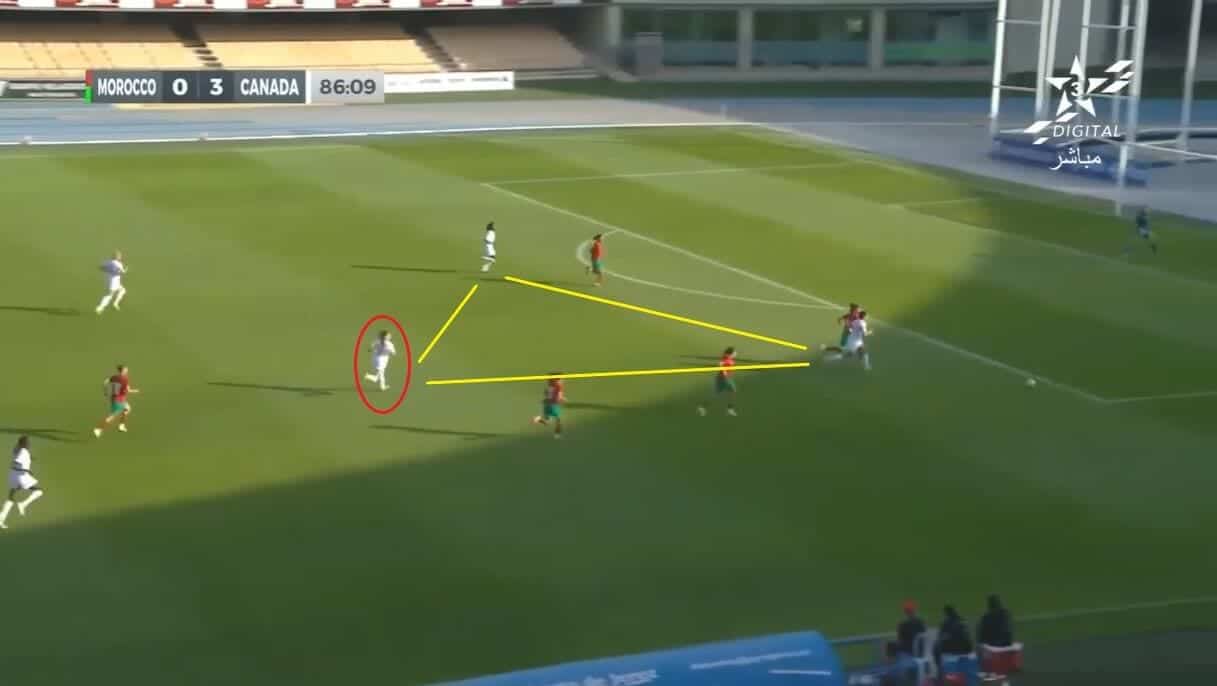
However, what needs to be considered about Larisey is that, as with Prince, she is more of a wide forward than a winger and so does like to cut inside and link up with teammates when looking to move the ball forward. Therefore, whilst her quality and precision on the ball are highly commendable, she would pose the same risk as Lacasse and, even though she will is also out with injury, Prince, in that there is a chance that she could leave the wide channels open and make it too easy for opponents to close Canada down.
With that in mind, Priestman would need to have a contingency plan in place to ensure that they didn’t lose the width if this did happen, and it might be worth waiting to deploy Larisey once they need more numbers in the middle of the pitch.
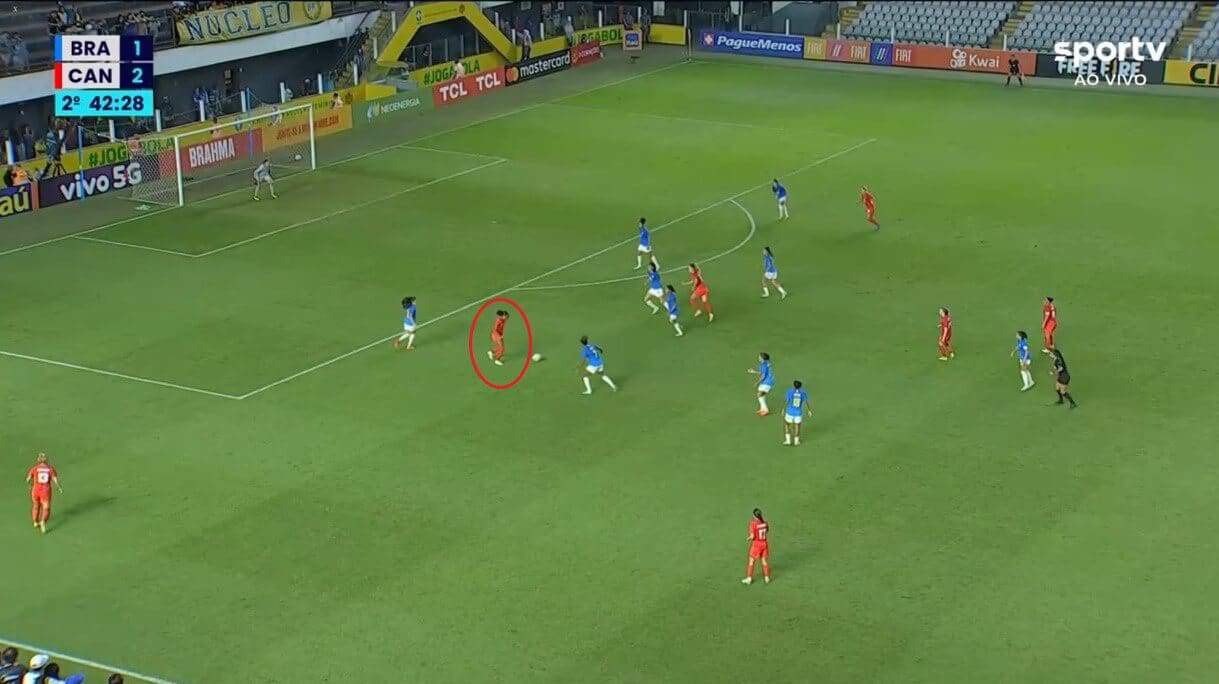
Another option could be 18-year-old Amanda Allen, who has already been given minutes for Canada during their last few international breaks and who is another tipped for a bright future on the international stage. With her key qualities being assurance on the ball, an ability to drive towards the goal line and a tendency to create problems for opponents, there is no doubt that she would not be a bad option to have in the squad now that Beckie will be missing from the World Cup squad.
Her age and inexperience may count against her when it comes to starts, but she is definitely a player worth keeping an eye on as Canada continue their preparations for the trip to Australia and New Zealand, and, with her having some of the qualities that Priestman is looking for in a replacement for Beckie, she might well get the nod at some point to go out and show what she can do.
Conclusion
In conclusion, this tactical analysis has looked to provide an answer to a very difficult question, in that it has tried to find a few ways for Canada to replace the wide attacking presence of injured forward Janine Beckie.
The simple fact is that there is no obvious answer, with this scout report providing several solutions but not really offering a definite answer. A change of shape has been suggested, along with an analysis of how that might help Canada to not limit the key strengths of their forwards, and some new names who might go some way to matching Beckie’s profile have been listed.
However, ultimately, it would not be a surprise to see Bev Priestman not really deciding how to solve this problem until just before the first game of the World Cup, because it is such a difficult conundrum to solve, and it will be interesting to see how Canada set up and which way they do go when the action does finally get underway.




Comments